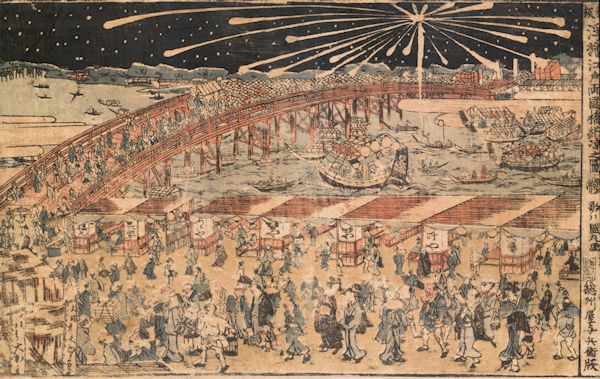| Title: |
Fireworks at Ryogoku Bridge |
| Artist: |
Kunimaru (Japan, 1794 - 1829) |
| Date: |
c. 1820 |
| Medium: |
Original Japanese Woodcut |
| Note: |
Kunimaru: The Utagawa school was founded by the great
late eighteenth century woodcut artist, Toyokuni (1769-1825). This school
of art would dominate the development of the Japanese woodcut throughout
the entire nineteenth century, producing such influential designers as
Toyokuni II, Kunimaru, Kunisada, Kuniyoshi and finally, Yoshitoshi. Born
the son of a pawnbroker in the capital city of Edo, Kunimaru first followed
in his master's footsteps, producing full length woodcuts of actors and
beautiful women (called, 'bijin-ga'). By the end of his short life he
had gained a strong reputation and became a master in his own right, teaching
such artists as Shigemaru, Toshimaru and Teruhito. |
| |
Fireworks at Ryogoku Bridge is quite possibly Kunimaru's
most remarkable work of art. The annual fireworks at this famous bridge
had been depicted by many other artists such as Toyokuni and Toyohisa.
Yet what makes this original woodcut so valuable is that it is one of
the first examples in Japanese art of that rare creation termed, 'perspective-print
style'. Historically, Japan was almost a completely closed society until
the mid 1860's. Commerce with the outside world was closely restricted
to the ports of Nagasaki and Yokohama, and the few Dutch and Chinese merchants
that resided there were secluded. Western art was as alien to Japan as
the customs and dress of the foreigners. Only a handful of Dutch old master
engravings and etchings made it into the hands of curious Japanese artists. |
| |
Perhaps the greatest difference between the development
of European art and that of Japanese art lies in the use of perspective.
Classic Japanese art deliberately flattens distance and space to strengthen
design elements. When the Japanese woodcut was introduced to the West
it had an immediate and profound impact upon the art of Van Gogh, Gaugin,
Toulouse-Lautrec and many others. Similar elements occurred when Japanese
artists were confronted with Western art, and Fireworks at Ryogoku
Bridge is one of the earliest examples of a Japanese artist attempting
to render perspective and distance. |
| |
In this wonderful view, Kunimaru has depicted the many stalls and activities in the foreground. The famous bridge is seen at full length leading across the river to the far bank and its buildings. Fireworks illuminate the night sky. This is a most charming, scarce woodcut in the perspective-print style. |
| Size: |
Oban (Sizes in inches are approximate,
height preceding width of plate-mark or image.) |
| |
Framed and Matted with 100% Archival Materials |
| |
View larger Framed Image |
| |
 |
| Condition: |
Printed upon early nineteenth century Japanese mulberry
(rice) paper and with full margins as published around 1820. Signs of
rubbing exist (particularly in the foreground) else a finely printed impression
retaining its full colouration. As mentioned earlier, Fireworks at
Ryogoku Bridge is a scarce and early woodcut and represents a very
important example of the art of Kunimaru. |
| Price: |
Sold - The price is no longer available. |
| Important Information: |
The artist biographies, research and or information pertaining to all the original works of art posted on our pages has been written and designed by Greg & Connie Peters exclusively for our site, (www.artoftheprint.com). Please visit us regularly to view the latest artworks offered for sale. We will soon be posting an update of our most recent research and include the biographical and historical information pertaining to our next collection of original works of art created by artists throughout the centuries. We hope you found the information you were looking for and that it has been beneficial.
Our Gallery, (Art of the Print / www.artoftheprint.com) guarantees the authenticity of every work of art we sell 100%. Full documentation and certification is provided. We offer a wide selection of international fine art dating from the early Renaissance to the contemporary art period. |





![]()
![]() or
phone Greg & Connie (905) 957-6666
or
phone Greg & Connie (905) 957-6666